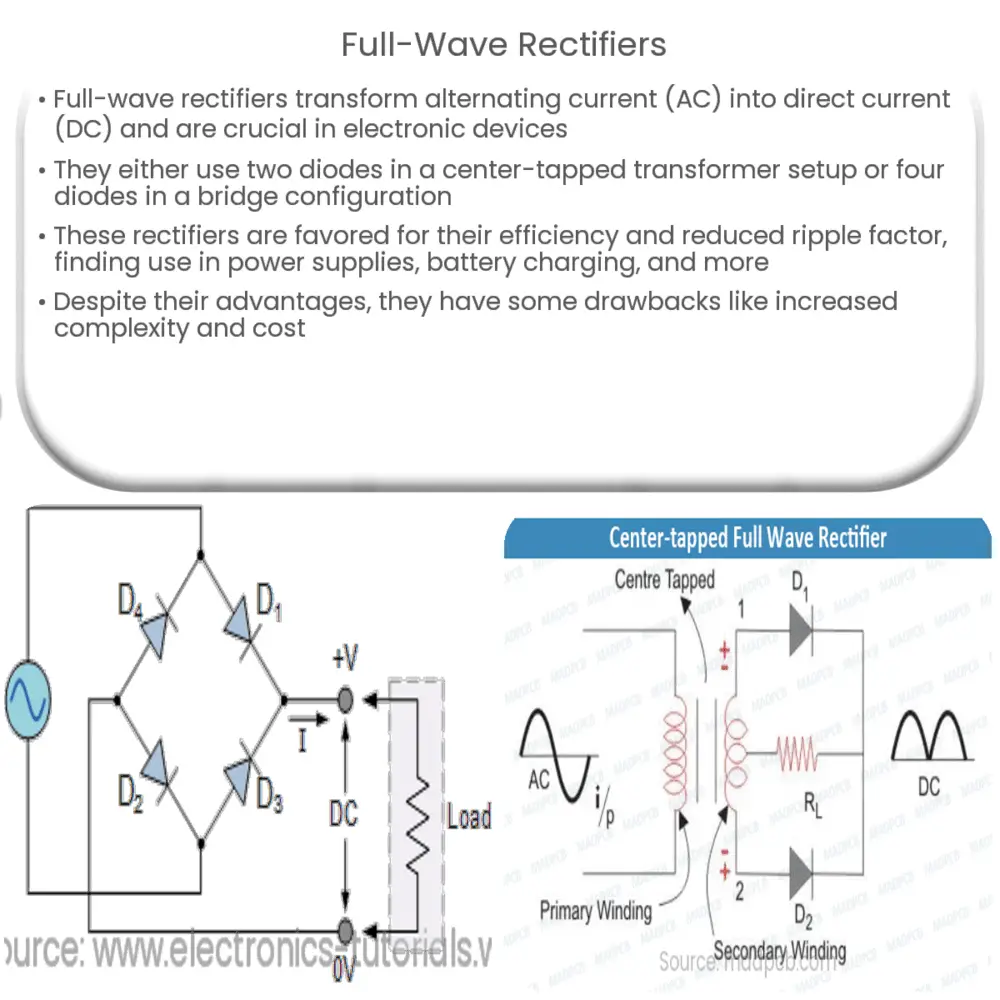Explore the concept of full-wave rectifiers, their working principles, applications, advantages, and drawbacks in our comprehensive guide.

Understanding Full-Wave Rectifiers
Full-wave rectifiers are an integral part of electronic devices, serving a critical role in the process of transforming alternating current (AC) into direct current (DC). They allow electronic gadgets to function on the AC power supply while working internally on DC.
Let’s delve deeper into the working and application of full-wave rectifiers.
The Principle of Full-Wave Rectification
In simple terms, rectification refers to the conversion of AC into DC. While a half-wave rectifier eliminates the negative or positive half of the AC signal, a full-wave rectifier inverts the negative half and combines it with the positive half, thus doubling the frequency of the output signal and ensuring a smoother output.
The Working of Full-Wave Rectifiers
Full-wave rectifiers function by using two diodes in a center-tapped transformer configuration or four diodes in a bridge configuration. Let’s explore these setups more closely:
- Center-Tapped Full-Wave Rectifier: This setup involves a center-tapped transformer and two diodes. The center tap serves as the ground point or the reference point. During the positive half cycle, one of the diodes is forward-biased, allowing current flow, while the other is reverse-biased, blocking current. The situation reverses during the negative half cycle.
- Bridge Full-Wave Rectifier: This setup utilizes four diodes. Unlike the center-tapped version, it doesn’t require a center-tapped transformer, which makes it cost-effective and allows it to work with a higher voltage. The diodes are arranged in a diamond shape that forms a bridge, hence the name. Two diodes become forward-biased during each half cycle, allowing current to flow in the same direction during both cycles.
Applications of Full-Wave Rectifiers
Full-wave rectifiers find widespread use in various applications owing to their efficient performance and reduced ripple factor. They are utilized in:
- Power supply units of electronic devices
- Battery charging circuits
- DC motor controls
- Amplitude modulation circuits
To summarize, full-wave rectifiers serve as a critical component in many electronic devices, converting AC to DC with increased efficiency and lower ripple effect compared to their half-wave counterparts. Their practical design options and wide-ranging applications make them a popular choice in the electronics industry.
Advantages and Disadvantages of Full-Wave Rectifiers
Like all electronic components, full-wave rectifiers have their own set of advantages and disadvantages that make them suitable for certain applications over others. Understanding these benefits and limitations can help in choosing the appropriate rectifier type for a given application.
Advantages
- Efficiency: Full-wave rectifiers are more efficient compared to half-wave rectifiers because they utilize both the positive and negative half cycles of the input signal.
- Ripple Factor: They have a lower ripple factor, which means the output is less fluctuating, thus producing a smoother DC signal.
- Transformer Utilization Factor (TUF): Full-wave rectifiers have a higher TUF than half-wave rectifiers, indicating a more efficient use of the transformer.
Disadvantages
- Complexity: Full-wave rectifiers, particularly the bridge type, have a more complex circuit design compared to half-wave rectifiers.
- Cost: They require more diodes, which can increase the overall cost of the circuit, especially for the bridge type full-wave rectifier.
- Voltage Drop: Full-wave rectifiers experience a higher voltage drop because the current needs to pass through two diodes in each half cycle in a bridge rectifier configuration.
Conclusion
In conclusion, full-wave rectifiers play an essential role in the operation of numerous electronic devices. Their ability to convert both halves of an AC signal into DC, thus improving efficiency and producing a smoother output, is a significant advantage over half-wave rectifiers. While they do have a few disadvantages, such as increased complexity and cost, their benefits often outweigh these drawbacks in many practical applications.
The understanding of full-wave rectifiers is a fundamental concept in electronics and power supply design, and their study continues to be of great relevance in a world increasingly dependent on electronic devices.

